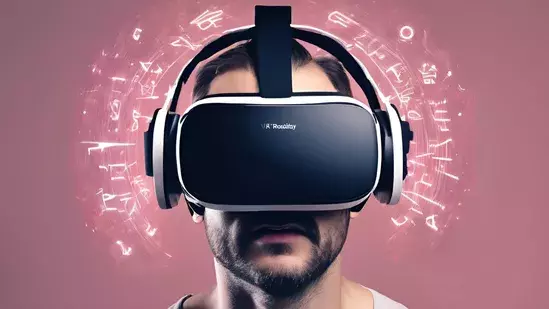VR spatial audio: How tech tricks your brain into hearing a whole new dimension 🤯

Virtual reality (VR) delivers stunning visuals that put you at the centre of fantastical worlds and experiences. But, what if we told you that there’s a whole other dimension to making VR truly immersive? That’s the magic of spatial audio.
This technology has the power to transport you from merely seeing a virtual world to feeling like you’re truly inside it. In this blog post, we’ll dive deep into VR spatial audio, explaining what it is, how it works, and why it’s rapidly revolutionizing the VR landscape.
What is VR Spatial Audio?
Spatial audio replicates how we hear sound in the real world. While regular stereo creates a left-right soundscape, spatial audio gives sound directionality and depth. Imagine you’re in a VR forest – with spatial audio, you’ll hear a bird chirping above you to your right, the rustling of leaves near your feet, and a river flowing somewhere in the distance. Your brain receives cues, allowing you to pinpoint the precise location of these sounds, adding a heightened layer of realism.
How Does Spatial Audio Achieve Realism?
Here’s a breakdown of the key concepts:
- Binaural Audio: The foundation of spatial audio, binaural audio utilizes two microphones to mimic human ears, capturing how sound subtly differs between them. These differences tell your brain a sound’s direction and distance.
- Head-Related Transfer Functions (HRTFs): Everyone’s head and ear shape differ. HRTFs are algorithms that personalize spatial audio, adjusting how sound waves reflect around your specific shape to fool you into believing audio is coming from its proper virtual source.
- Ambisonics: Ambisonics, especially higher-order formats, encode audio more effectively than traditional surround sound. They allow for the smooth positioning of audio sources anywhere in the 3D space around you, making it perfect for fluid experiences where you move about a virtual world.
Read More: VR Headset Parts: 7 Essential Components
The Magic of Spatial Audio in VR
Here’s where it gets truly awesome:
- Deep Immersion: Virtual Reality spatial audio obliterates the boundary between the virtual and real. Well-implemented spatial audio makes you feel physically present in the VR environment.
- Heightened Storytelling: In VR films and experiences, spatial audio directs your attention. Gunshots sound believable alongside dialogue and score, pulling you into the narrative.
- Gameplay Advantage: Competitive VR games? Spatial audio lets you discern enemy footsteps, their direction, and possible distance – a massive advantage.
- Unmatched Realism in Simulation: Flight simulators, surgery training, and more are elevated by spatial audio. Hearing cockpit instruments from their proper place or a virtual patient’s heart beating accurately are game-changers for VR training.
Virtual Reality Spatial Audio in Practice
You’ll find spatial audio across various platforms and experiences:
- VR Headsets: Most major VR headsets, like Meta Quest, Valve Index, and PlayStation VR2, support spatial audio.
- Games: Titles like Resident Evil Village, Half-Life: Alyx, and Microsoft Flight Simulator showcase how effective spatial audio can be.
- 360-Degree Videos: Nature documentaries, concerts, or sports events all become more engaging with the ability to locate where sounds are ‘happening’.
- Wellness and Meditation: Apps use spatialized soundscapes and nature sounds to help with relaxation and focus.
Experiencing Spatial Audio
Spatial audio is best experienced first-hand. Here’s how:
- Gear Up: Make sure your VR headset and headphones support spatial audio.
- Find Content: Seek out games, experiences, or videos that advertise spatial audio support.
- Listen: Take some time to notice how the audio reacts as you look around within the VR environment. How real does it feel?
The Future of VR Audio
VR audio is just reaching its full potential. We expect advances like real-time audio customization based on your unique HRTF. AI-powered VR audio generation could open up dynamic soundscapes that shift with your actions. In a world racing towards the metaverse, spatial audio becomes critical for believable interactions and shared experiences.
FAQ:
What exactly is Spatial Audio?
Spatial Audio is a technology that simulates the way sound behaves in real-world environments within virtual reality (VR) experiences. It goes beyond traditional stereo by creating a soundscape that has depth, direction, and distance. With spatial audio, sounds in a VR game or simulation can seem to come from above, below, behind, or in front of you, greatly enhancing immersion and believability.
How does VR Audio improve the VR experience?
VR Audio adds a new dimension to virtual reality. Imagine playing a VR game where you can pinpoint an enemy by their footsteps, or a horror game where a ghostly whisper sends a chill down your spine because it sounds like it’s right behind you. It enhances immersion, making the virtual world feel more real, and delivers gameplay advantages in titles where accurate sound perception is important.
Do I need special equipment to experience Virtual Reality Spatial Audio?
Generally, yes. To experience the full effect, you’ll need a VR headset with headphones that support spatial audio capabilities. Many modern VR headsets have this functionality built-in, and there are also specialized headphones designed for optimal 3D audio effects in VR. Some software can simulate spatial effects with regular stereo headphones, but the effect may be less pronounced.
